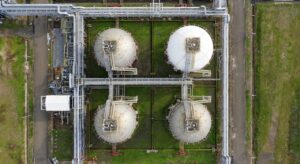Geothermal energy is energy derived from the natural heat of the earth. This heat can be achieved by means of wells. The geothermal gradient in a well increases by 1 0C every 36 meters. This heat is delivered to the surface in the form of steam or hot water. This heat can be used both directly to heat homes and buildings and to generate electricity. There are thermal regions in many parts of the world.
According to various calculations, the temperature at the center of the Earth is at least 6 650 0C. The Earth’s rate of cooling is about 300-350 0C per billion years. The Earth contains 42 x 1012 W of heat, of which 2% is in the crust and 98% in the mantle and core. Current technology cannot reach the heat that is too deep, but the 840,000,000,000,000 W (2%) of available geothermal energy can provide the needs of mankind for a long time. The areas around the edges of continental plates are the best places to build geothermal plants because the crust in such areas is much thinner.
The deeper the well, the higher the temperature, but in some places the geothermal temperature rises faster. Such places are usually in areas of high seismic activity, where tectonic plates collide or rupture. This is why the most promising geothermal resources are in areas of volcanic activity. The higher the geothermal gradient, the cheaper it is to produce heat, due to lower drilling and pumping costs. In the most favorable cases, the gradient can be so high that surface waters are heated to the desired temperature. Geysers and hot springs are examples of such cases.
Below the earth’s crust is a layer of hot and molten rock called magma. Heat arises there primarily from the decay of naturally occurring radioactive elements such as uranium and potassium. The energy potential of heat at a depth of 10,000 meters is 50,000 times more energy than all of the world’s oil and gas reserves.
Zones of the highest underground temperatures are in regions with active and young volcanoes. Such “hot spots” are at the boundaries of tectonic plates or in places where the crust is so thin that it lets magma heat through. There are many hotspots in the Pacific Rim, also called the “ring of fire” because of the large number of volcanoes.
There are two main ways to use geothermal energy: direct use of heat and electricity generation. Direct use of heat is the simplest and therefore the most common method. The practice of direct use of heat is widespread in high latitudes at the borders of tectonic plates, for example in Iceland and Japan. The water pipeline in such cases is mounted directly into deep wells. The resulting hot water is used to heat roads, dry clothes and heat greenhouses and residential buildings. The way of producing electricity from geothermal energy is very similar to the way of direct use. The only difference is the need for higher temperatures (over 150 0C).
In California, Nevada and some other places geothermal energy is used in large power plants, e.g. in California about 5% of the electricity is produced by geothermal energy and in El Salvador about 1/3 of the electricity is produced by geothermal energy. Idaho and Iceland use geothermal heat in a variety of applications, including home heating. Thousands of homes use geothermal heat pumps to provide clean and affordable heat.
Geothermal power plants are sources of geothermal energy.
Dry heated rock – In order to harness the energy in geothermal power plants contained in dry rock, water is pumped into the rock at high pressure. This expands existing fractures in the rock and creates an underground reservoir of steam or hot water.
Magma is a molten mass formed under the Earth’s crust. The temperature of magma reaches 1,200 0C. Although small amounts of magma are found at accessible depths, practical methods of generating energy from magma are still under development.
Hot, pressurized groundwater containing dissolved methane. Both heat and gas are used in power generation.
There are currently three hydrothermal power generation schemes: direct with dry steam, indirect with water steam, and a mixed production scheme (binary cycle). The type of conversion depends on the state of the medium (steam or water) and its temperature. Dry steam power plants were the first to be developed.


